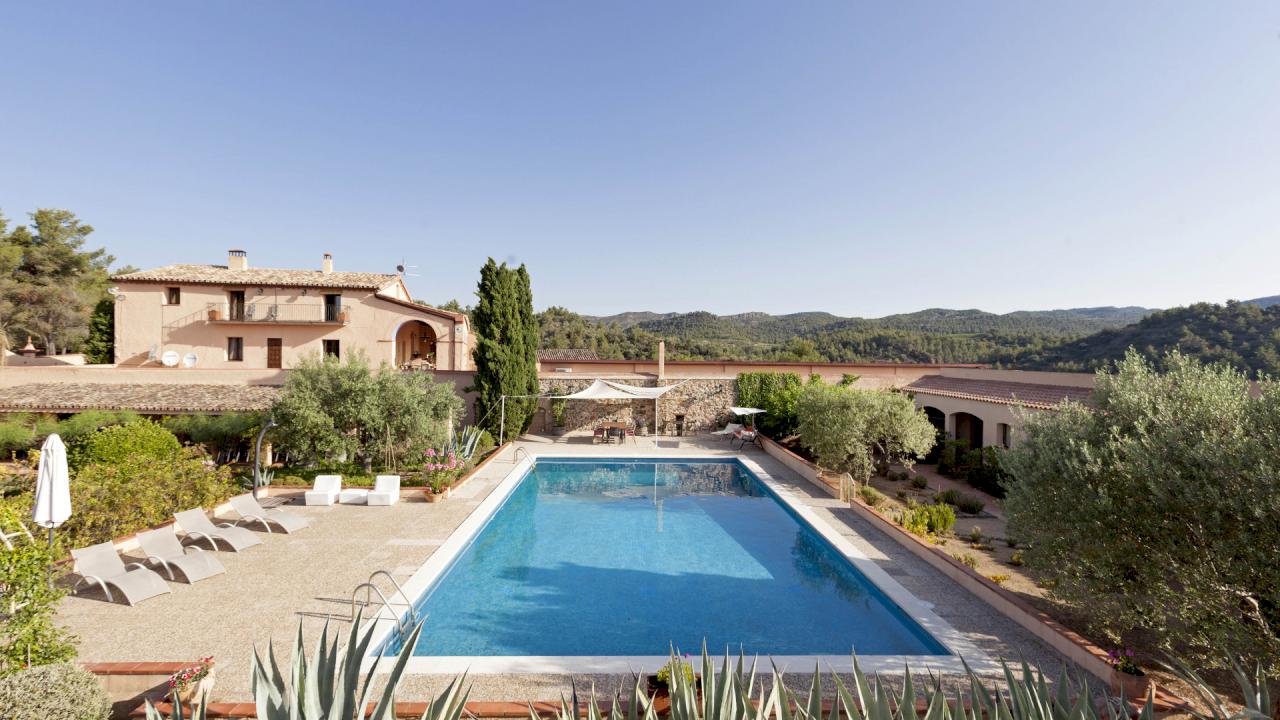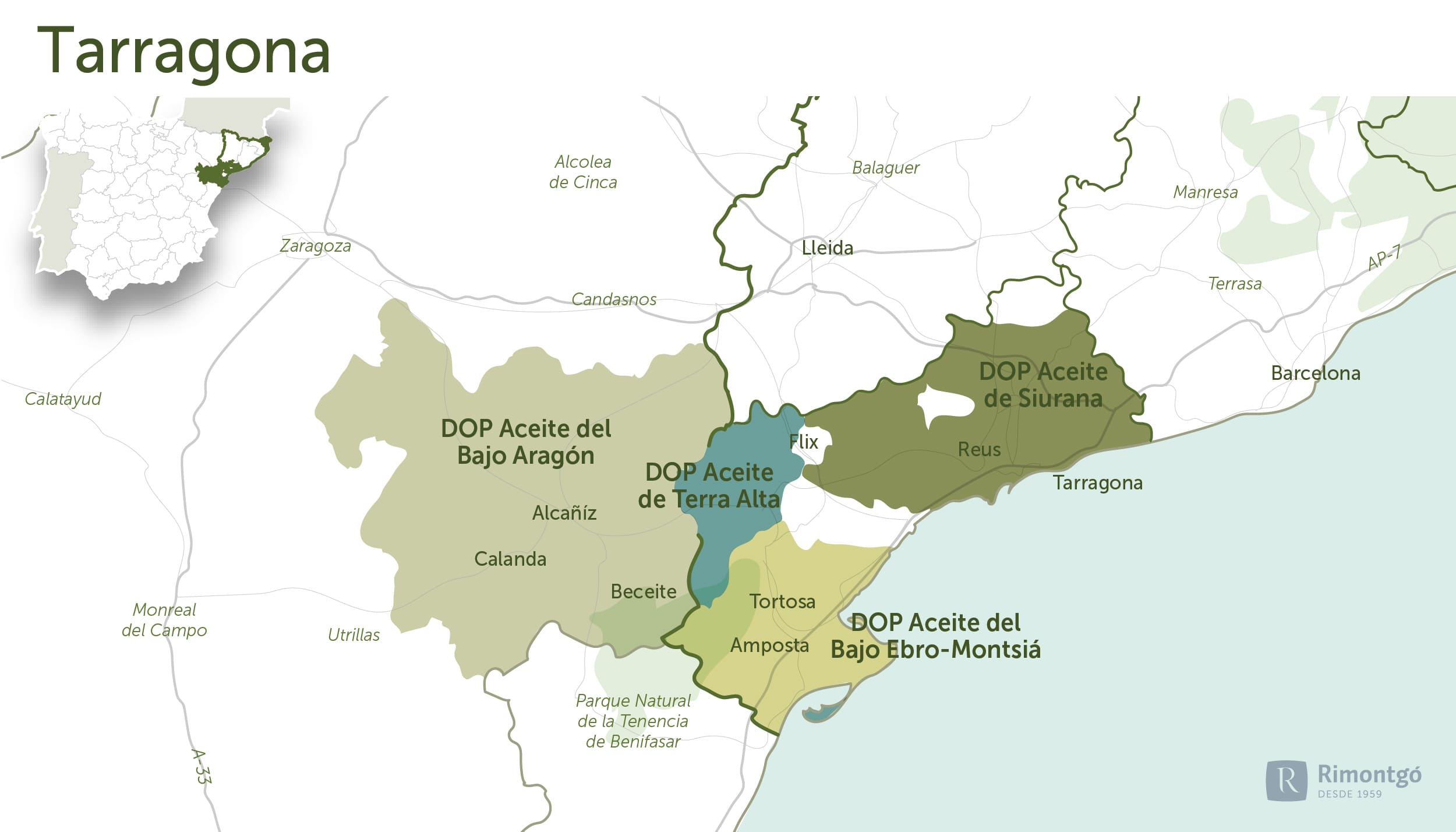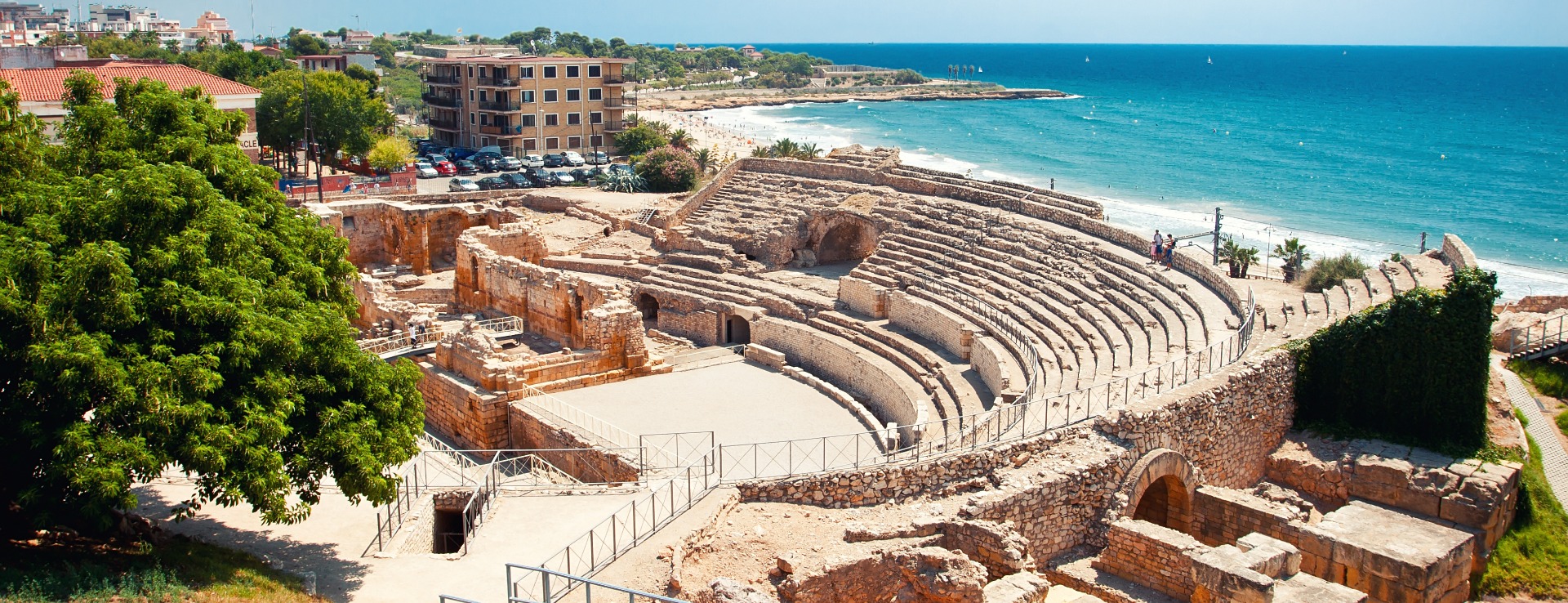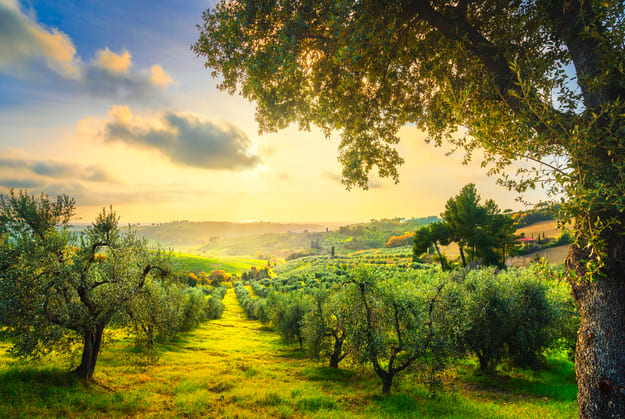Find your olive grove or oil mill
1 Olive groves and oil mills for sale in Tarragona

Spectacular Masía for sale with ancient olive trees and vineyards.
DOP Siurana and DOQ Priorat
Infographic of the area

Tarragona
In the province of Tarragona there are several olive oil DOs, DOP Siurana, DOP Baix Ebre-Montsià and DOP Terra Alta.
DOP Siurana
It is made up of the Tarragona counties of El Priorat, El Baix Camp, El Alt Camp, El Tarraconès and La Ribera d'Ebre. This oil owes its name to the river Siurana, a tributary of the Ebro River that rises in the Priorat region and bathes three of the seven regions of our territory: El Priorat, Tarragonès, Ribera de l'Ebre, Alt and Baix Camp, Cuenca de Barberà and Baix Penedès.
Varieties
The oils are made from the Arbequina, Royal and Morrut varieties. This oil is rich in vitamins A, D, K and especially E, already known and appreciated by the Romans. It comes from olive trees located from the eastern slopes of the Siera de la Llena to the sea.
The Arbequina olive variety, whose name comes from the Arbeca district where it was first cultivated, originally comes from Majorca, from where, according to tradition, it was King James I who brought it to Catalonia. It was one of his feudal subjects, the Lord of Arbeca, who planted this type of olive tree in his fief because of its advantages, the excellent quality of the oil produced and its early fruiting.
Climate and soils
The topography of the counties is rugged. The altitude of the area ranges from 1000 to 100 metres above sea level.
The soils come from the Carboniferous, Jurassic, Cretaceous and marine Miocene.
The climate is Mediterranean with marine influence, with a lot of wind. The average annual rainfall is 450 mm. The average annual temperature is 16º C. The minimum temperatures are 5º C below zero.
Olive oil mills
The Ulldemolins Cooperative deserves special mention for its recognition in the area.
CA La Canonja, CA Capçanes, CA de La Bisbal de Falset, CA de Montroig, CA de Picamoixons, CA Pont D'armentera, CA Sant Jaume Apóstol, CA Alforja, CA Almoster, CA Cabacés, CA Castellvell, CA Constanti, CA El Molar, CA. La Figuera, CA La Palma D`Ebre, CA La Serra D`Almos, CA. Les Borges del Camp, CA Maspujols, CA. Montbrio, CA Riudecanyes, CA. Riudecanyes, CA. Riudoms, CA. Vila-Seca, CA. La Selva del Camp (COSELVA), L'avellanera i Secció de Crèdit SCCL, Molí de La Mola Scc., Olis Sole S.L., Unió Corporació Alimentária.
DOP Aceite de Baix Ebre-Montsià
The Tarragona regions of Baix Ebre and Montsià, bordering Castellón and Teruel.
Varieties
This olive oil varies from greenish yellow to golden yellow in colour and is produced with the morruda or morrut, sevillenca and farga varieties.
History
From a historical point of view, the origin of olive-growing in Catalonia and particularly in the Baix Ebre and Montsià regions must be attributed to the Arabs, so much so that the name 'almazaras' for olive oil mills is still a clear reference to this Arab origin.
In history, 'the great oil market of Tortosa, which was the first manufacturer and the first market for fine olive oil, with nineteen traders dedicated exclusively to the oil trade, selling to both Spanish and French people', stands out. Likewise, as a result of this quality, the master oil makers created a school, advising other municipalities on the art of making oil 'because the oil from this area was the most appreciated, teaching how to make it in Toledo, Lower Aragon and the province of Lérida'. This region was the first in Spain to initiate advances in the production of olive oil by cold-working the olives, the olive-growing ancestry in which olive-growing is developed, especially in the municipalities of Tortosa, Roquetes and other adjacent areas.
Climate and soil
From the natural point of view, the Baix Ebre-Montsià olive-growing area is fully marked by the presence of the River Ebro with the valley formed between the mountains that are the southernmost foothills of the Catalan Pre-coastal Range. To the right, a large part of the Massif of the Tortosa-Beseit mountain passes, with its highest point, the Caro (1447) and to the left the Cardó and Boix mountain ranges, with the tempering effect of the Mediterranean Sea.
As far as the soils are concerned, they are of highly eroded calcareous origin, with a limestone crust, known in the area as 'taperot'.
The climate in the DO area is maritime Mediterranean, with very mild winters and average annual maximum temperatures of 23ºC. This temperature is about 2ºC higher than the average annual maximum temperature of 23ºC in the DO area. This temperature is about 2ºC higher than in other nearby areas, which results in earlier and faster ripening of the fruit than in other nearby areas. Another distinguishing climatic element is the 'dalt' or 'mistral' wind (N-NW), dry and persistent, which blows very strongly in autumn and winter, channelled by the Ebro depression and accelerated by the aforementioned reliefs.
Oil mills
CAC of Freginals, CAC. Isdc. de Godall, CAC. la Galera, CAC. de la Sénia, CAC. Sant Isidre del Mas de Barberans, CAC. olive mill of Baix Ebre de Camarles, CAC. Sant Gregori de Santa Bàrbara, CAC. Sant Isidre del Perelló, CAC. Sant Roc de Paüls, CAC. del Camp Sta Bàrbara, CAC. Soldebre de Tortosa, CAC. . d'Ulldecona.
DOP Aceite de Terra Alta
It is bordered to the west by the provinces of Teruel and Zaragoza and the river Algars acts as a façade. The Ebro river and the Riba-roja d'Ebre reservoir also surround the region.
The denomination is made up of the 12 municipalities of Terra Alta, Arnes, Batea, Bot, Caseres, Corbera d'Ebre, la Fatarella, Gandesa, Horta de Sant Joan, el Pinell de Brai, la Pobla de Massaluca, Prat de Comte and Vilalba dels Arcs. And in the Ribera d'Ebre region, three municipalities, Ascó, Flix and Riba-roja d'Ebre.
Varieties
In the regions of Terra Alta and Ribera d'Ebre, in the southwest of Catalonia, the empeltre, arbequina, morruda and farga varieties produce an olive juice reminiscent of almonds and green walnuts. Empeltre is the main and traditional variety of Terra Alta. Its name derives from the Catalan word empelt, which means "graft". It was probably grafted onto other varieties from Lower Aragon and the Ebro river valley. Nowadays this variety is very important in this area of Tarragona. Nowadays it is also known as the Terra Alta variety.
The olive grove area is approximately 9,900 ha, which represents more than 29% of the total cultivated area of the region (33,000 ha). Of these, 4,200 ha are under the DO.
History
From a historical point of view, around 1900, olive groves were the second most important crop in the Terra Alta region, representing more than 28% of the cultivated land, with between 20% and 44% of the total area cultivated in all the municipalities. The municipalities with the largest areas under olive cultivation were Batea, La Fatarella and Horta de Sant Joan.
Climate and soils
Like most olive-growing areas, this area enjoys a Mediterranean climate. The altitude is a high plateau at an average of 400 m above sea level. The natural barriers: three mountain ranges converge in the county: the so-called "Pàndols" and "Cavalls" with maximum heights of 700 m and the most important, at the northern end with maximum heights of 1,400 m, called "Els ports de Beseit". All of this makes up a particular orography that gives it its microclimate.
In addition, and as a consequence of this, the area's own winds are also of great importance, not because of their strength (which they do not have in excess) but because of what they contribute to cultivation. The two most important winds, the "Garvinada" and the "Cerç", have their own name in the area. The former because it provides the necessary humidity for the crop and the latter because its characteristics and frequency prevent many health problems (fungus).
With regard to the soil, the most abundant is calcareous rock. A distinction is made between compact limestone and non-compact bedrock, also limestone.
Temperatures are conditioned by the mountainous barrier to the south, which means that they are not as moderate as on the nearby Mediterranean coast. Snow usually falls between January and February, and fog and frost usually appear in December and January. Winter temperatures drop below freezing and summer temperatures reach the 40s.
Rainfall in normal years is between 450 and 500 mm. The soil does not retain much water, so there is little humidity.
Olive oil mills
CAC. De Crèdit Terra Alta, Celler Cooperatiu Gandesa, CAC. Sant Isidre, CAC. Isdc. Sant Josep, CAC. d'Arnes, Olis de la Franja, SL, CAC. de R.L.S, CAC. Sant Isidre, Agrària Sant Salvador d'Horta, Vallespí-Vidal,SL, Covilalba, CAC. d'Ascó, Oliflix, SL, Fruit Nature, SL, Pinellense, Escola de Capacitació Agrària, Cooperativa Agrícola de Corbera d'Ebre.
Subscribe to our mailing list to receive news about olive groves and oil mills.



